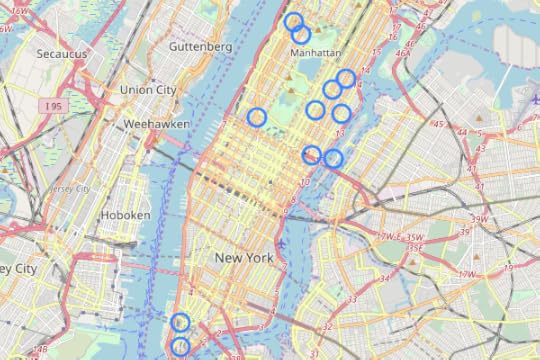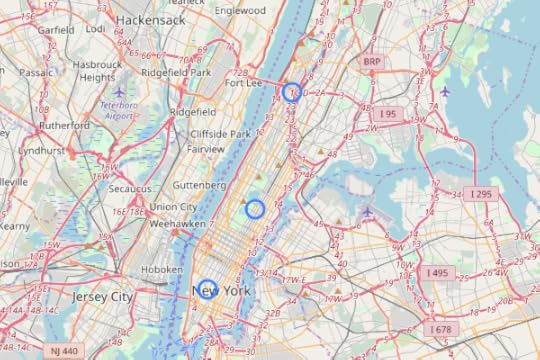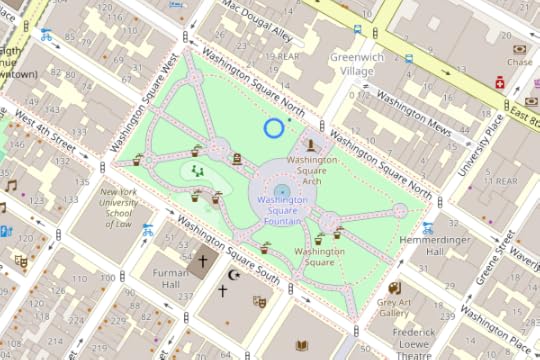Ken Poirot's Blog - Posts Tagged "illustration"
Data Science Illustration: Where to Put the Next Starbucks in Manhattan?
The Emergence of Data Science
Recently I completed the coursework for the IBM Data Science Professional Certification program available online through Coursera.
Even though Data Science has been "named the best job in America for three years running" (Forbes) and "The Sexiest Job of the 21st Century" (Harvard Business Review), most people I meet on a daily basis are still unfamiliar with Data Science.
I am often asked, "What is Data Science?"
Data Science Defined
Simply, Data Science is manipulating data, looking for patterns, and coming up with solutions to drive revenue, lower expenses, and thereby increase overall business profitability.
Data Science takes the guesswork/emotions out of answering business questions by applying logic and mathematics to find better solutions.
As such, Data Science is a combination of art and science, limited only by the extent of freedom afforded the data scientist to explore coupled with their creative abilities.
For example, whenever you go to Netflix or Amazon and receive recommendations based upon what other people just like you also liked or purchased...all these recommendations came directly from Data Science.
The Importance of Data Science to Corporate America
As every industry is beginning to see the benefits data science can provide, all industries are hiring (or beginning to hire) data scientists. In fact, a recent blog post by IBM cited the following study and statistics:
I foresee the next wave of revenue growth in corporate America will come directly from Data Science. Decades from now, Americans will look back at this time, when Data Science was at its infancy, and liken its societal impact to that of the Industrial and Technological Revolutions.
The corporations that embrace Data Science will find their long-term, generational growth directly proportional to how effectively they incorporated data scientist teams into their strategic planning.
With this in mind, below is the result of my last project to earn the IBM Professional Certificate in Data Science.
What follows is an example of a problem Data Science can solve mathematically (in this case using Python and its existing mapping and machine learning libraries).
Data Science Illustration: Where to Put the Next Starbucks in Manhattan?
The following illustration was created from data obtained using the Foursquare API (Application Program Interface).
Like all Science experiments, Data Science begins with asking a question (hypothesis); in this specific illustration the question is, "Where to put the next Starbucks in Manhattan?"
In this illustration, we are making the following assumptions:
First, our marching orders from Starbucks are they want to chip away at their competitors' market share (after all, business is a war sometimes fought by squeezing out the competition).
Second, where Starbucks' competitors are most densely located in Manhattan are high foot traffic and high coffee demand areas most frequented by coffee consumers/coffee shop patrons.
Third, for this illustration we are also assuming the data provided by the Foursquare API is accurate and all-inclusive. Since the data is crowdsourced and as we know, us humans are fallible, there may be some discrepancies in the data.
For this reason, if I was working with a client, like Starbucks, I would ask Starbucks to provide their current locations to me in some written form. Therefore, Starbucks could not come back and claim their current location data is not accurate, as they would be the ones who supplied this data in the first place (and I would have the written documentation to prove it).
Below is a map I created showing the locations of Starbucks' competitor coffee shops in Manhattan (the map was made using Python, the Foursquare API data, and Python's Folium mapping library):

Here is a more close up view of the same map of Starbucks' competitors' locations so the more dense areas can be viewed with better resolution:

The map below shows Starbucks' current Manhattan locations based on the Foursquare API data:

Data Analysis of Starbucks' Competitors' Locations
The benefits of using Python for data analysis are the myriad of mathematical and machine learning algorithm libraries available.
For this particular business problem, I used the k-means clustering algorithm to find the best location for the new Starbucks in Manhattan.
Explaining in detail how the k-means machine learning algorithm works is beyond the scope of this post, however, for those who would like to explore this further here is a link with more information:
k-means Clustering Algorithm
In a nutshell, k-means puts data into groups, called clusters, based upon measuring distance between data points (coffee shop locations in this case). The data is grouped into various clusters over and over again until the center of the cluster no longer moves. The center of the clusters is then mathematically defined (the center of each cluster is called its centroid).
An assumption we have to make in order to run the k-means Clustering Algorithm is the number of clusters. From the map of Manhattan, the locations on the map, and the geography of Manhattan, the number of clusters assumed here is three (representing Lower Manhattan, Central Manhattan, and Upper Manhattan).
The three centers (centroids) for the locations of Starbucks' competitors' coffee shops were computed mathematically and plotted on the map below:

Based upon these computations, the best location for the new Starbucks in Manhattan is Lower Manhattan's Washington Square Park, with the calculation specifying, Latitude:40.731130, Longitude: -73.997801.
This above location is magnified below for a clearer view:

Starbucks' Proposed Washington Square Park Location
Obviously, Starbucks cannot put a brick and mortar coffee shop right in Washington Square Park. However Starbucks should try to find a location as close to this point as possible.
Knowing the sky high cost of opening a brick and mortar location in Manhattan (upwards of $300,000+ according to TouchBistro.com), and that vacant lease space can be difficult to find, I suggest Starbucks starts with a coffee cart.
A Starbucks coffee cart would save Starbucks the time and cost of finding/building out a location while they search for a nearby more permanent location.
Furthermore, Starbucks can either outright buy a coffee cart with an existing license (New York stopped issuing licenses for new food/coffee carts many years ago) from its current owner, or sponsor/pay a coffee cart owner to distribute Starbucks' coffee for them.
Some of the metrics and information with regard to food/coffee carts in Manhattan can be found here:
NYMag.com
Starbucks' Suggested Washington Square Park Coffee Cart Marketing Campaign
In the meantime, Starbucks can have fun with their coffee cart, generate a buzz, and some good will by engaging their customers.
I suggest enlisting the help of their patrons with an official contest to help Starbucks bird dog the best lease space for the new Starbucks brick and mortar coffee shop. Therefore, a Starbucks coffee cart in Washington Square Park could also become a great marketing campaign for Starbucks.
Additionally, a coffee cart is also a great way to test the coffee consumer market in and around Washington Square Park today for a fraction of the time/cost it will take to open/build their eventually more permanent brick and mortar location.
Warmly,
Ken Poirot
Recently I completed the coursework for the IBM Data Science Professional Certification program available online through Coursera.
Even though Data Science has been "named the best job in America for three years running" (Forbes) and "The Sexiest Job of the 21st Century" (Harvard Business Review), most people I meet on a daily basis are still unfamiliar with Data Science.
I am often asked, "What is Data Science?"
Data Science Defined
Simply, Data Science is manipulating data, looking for patterns, and coming up with solutions to drive revenue, lower expenses, and thereby increase overall business profitability.
Data Science takes the guesswork/emotions out of answering business questions by applying logic and mathematics to find better solutions.
As such, Data Science is a combination of art and science, limited only by the extent of freedom afforded the data scientist to explore coupled with their creative abilities.
For example, whenever you go to Netflix or Amazon and receive recommendations based upon what other people just like you also liked or purchased...all these recommendations came directly from Data Science.
The Importance of Data Science to Corporate America
As every industry is beginning to see the benefits data science can provide, all industries are hiring (or beginning to hire) data scientists. In fact, a recent blog post by IBM cited the following study and statistics:
"According to a recent Linkedin study, the Linkedin Workforce Report, Aug. 2018, there are currently more than 151,000 data scientist jobs going unfilled across the U.S., with 'acute' shortages in New York City, San Francisco, and Los Angeles."
I foresee the next wave of revenue growth in corporate America will come directly from Data Science. Decades from now, Americans will look back at this time, when Data Science was at its infancy, and liken its societal impact to that of the Industrial and Technological Revolutions.
The corporations that embrace Data Science will find their long-term, generational growth directly proportional to how effectively they incorporated data scientist teams into their strategic planning.
With this in mind, below is the result of my last project to earn the IBM Professional Certificate in Data Science.
What follows is an example of a problem Data Science can solve mathematically (in this case using Python and its existing mapping and machine learning libraries).
Data Science Illustration: Where to Put the Next Starbucks in Manhattan?
The following illustration was created from data obtained using the Foursquare API (Application Program Interface).
Like all Science experiments, Data Science begins with asking a question (hypothesis); in this specific illustration the question is, "Where to put the next Starbucks in Manhattan?"
In this illustration, we are making the following assumptions:
First, our marching orders from Starbucks are they want to chip away at their competitors' market share (after all, business is a war sometimes fought by squeezing out the competition).
Second, where Starbucks' competitors are most densely located in Manhattan are high foot traffic and high coffee demand areas most frequented by coffee consumers/coffee shop patrons.
Third, for this illustration we are also assuming the data provided by the Foursquare API is accurate and all-inclusive. Since the data is crowdsourced and as we know, us humans are fallible, there may be some discrepancies in the data.
For this reason, if I was working with a client, like Starbucks, I would ask Starbucks to provide their current locations to me in some written form. Therefore, Starbucks could not come back and claim their current location data is not accurate, as they would be the ones who supplied this data in the first place (and I would have the written documentation to prove it).
Below is a map I created showing the locations of Starbucks' competitor coffee shops in Manhattan (the map was made using Python, the Foursquare API data, and Python's Folium mapping library):

Here is a more close up view of the same map of Starbucks' competitors' locations so the more dense areas can be viewed with better resolution:

The map below shows Starbucks' current Manhattan locations based on the Foursquare API data:

Data Analysis of Starbucks' Competitors' Locations
The benefits of using Python for data analysis are the myriad of mathematical and machine learning algorithm libraries available.
For this particular business problem, I used the k-means clustering algorithm to find the best location for the new Starbucks in Manhattan.
Explaining in detail how the k-means machine learning algorithm works is beyond the scope of this post, however, for those who would like to explore this further here is a link with more information:
k-means Clustering Algorithm
In a nutshell, k-means puts data into groups, called clusters, based upon measuring distance between data points (coffee shop locations in this case). The data is grouped into various clusters over and over again until the center of the cluster no longer moves. The center of the clusters is then mathematically defined (the center of each cluster is called its centroid).
An assumption we have to make in order to run the k-means Clustering Algorithm is the number of clusters. From the map of Manhattan, the locations on the map, and the geography of Manhattan, the number of clusters assumed here is three (representing Lower Manhattan, Central Manhattan, and Upper Manhattan).
The three centers (centroids) for the locations of Starbucks' competitors' coffee shops were computed mathematically and plotted on the map below:

Based upon these computations, the best location for the new Starbucks in Manhattan is Lower Manhattan's Washington Square Park, with the calculation specifying, Latitude:40.731130, Longitude: -73.997801.
This above location is magnified below for a clearer view:

Starbucks' Proposed Washington Square Park Location
Obviously, Starbucks cannot put a brick and mortar coffee shop right in Washington Square Park. However Starbucks should try to find a location as close to this point as possible.
Knowing the sky high cost of opening a brick and mortar location in Manhattan (upwards of $300,000+ according to TouchBistro.com), and that vacant lease space can be difficult to find, I suggest Starbucks starts with a coffee cart.
A Starbucks coffee cart would save Starbucks the time and cost of finding/building out a location while they search for a nearby more permanent location.
Furthermore, Starbucks can either outright buy a coffee cart with an existing license (New York stopped issuing licenses for new food/coffee carts many years ago) from its current owner, or sponsor/pay a coffee cart owner to distribute Starbucks' coffee for them.
Some of the metrics and information with regard to food/coffee carts in Manhattan can be found here:
NYMag.com
Starbucks' Suggested Washington Square Park Coffee Cart Marketing Campaign
In the meantime, Starbucks can have fun with their coffee cart, generate a buzz, and some good will by engaging their customers.
I suggest enlisting the help of their patrons with an official contest to help Starbucks bird dog the best lease space for the new Starbucks brick and mortar coffee shop. Therefore, a Starbucks coffee cart in Washington Square Park could also become a great marketing campaign for Starbucks.
Additionally, a coffee cart is also a great way to test the coffee consumer market in and around Washington Square Park today for a fraction of the time/cost it will take to open/build their eventually more permanent brick and mortar location.
Warmly,
Ken Poirot
Published on February 05, 2019 16:04
•
Tags:
algorithm, america, author-ken-poirot, best-job-in-america, best-jobs-in-america, business, business-illustration, business-problem, business-solution, centroid, certified-data-scientist, cluster, clustering-algorithm, coffee, coffee-cart, coffee-consumer, coffee-shop, coffee-shop-customer, coffee-shop-customers, coffee-shop-patron, coffee-shop-patrons, coffee-shops, course, coursera, data, data-science, data-science-case-study, data-science-explanation, data-science-illustration, data-science-ken-poirot, data-science-problem, data-sciences, data-scientist, data-scientist-ken-poirot, data-scientists, folium, folium-map, folium-maps, forbes, foursquare, foursquare-api, foursquare-data, ibm, ibm-data-science, ibm-data-science-course, ibm-data-scientist, illustration, job, jobs, k-means, k-means-clustering, ken-poirot, lower-manhattan, manhattan, map, mapping, marketing, marketing-campaign, python, python-library, starbucks, starbucks-coffee-cart, starbucks-coffee-shop, starbucks-coffee-shops, starbucks-competitors, starbucks-locations, starbucks-marketing, starbucks-marketing-campaign, study, the-harvard-business-review, washington-square-park, what-is-data-science



